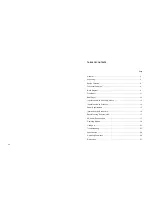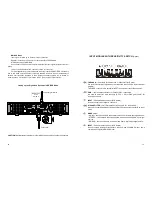
15
18
CABLE REQUIREMENTS
Input Cables
Make sure to use only shielded cables whether balanced or unbalanced. Shielding
when properly grounded protects a signal against external electrical interference.
As a rule, unbalanced lines of over 3 meters long are not acceptable. Greater distances
require a balanced cable. Avoid placing input cables close to power cords or power
transformers.
Output Cables
The amplifier is capable of delivering high level output current; therefore, the wire
gauge used for speaker cables is particularly important. Inadequate wire gauge adds
significant resistance to the speaker
’
s own impedance, reducing the power which is actually
delivered to the speaker. It will also result in a decreased damping factor and possible fire
hazard.
Since the power applied to the loudspeaker is of primary concern in system design, we
have included the table below to allow you determine the appropriate wire gauge for your
application.
The table shows the percentage of the power loss in a 10-meter copper multiple-core
cable. This table reflects the power loss as a percentage of the output power of the amplifier
applied to the load. Use this table to determine the power loss to the load at other cable
lengths. For example, if you plan to deliver 500 Watts to 8-Ohm load through 20 m of 1,5-mm
2
cable, the power loss in the cable would be 2,9 % x 2=5,8 % of 500 W or 29 W lost in the cable.
Wire Gauge
Cable
Resistance
Cable power loss
8 Ohm load
1,5 mm
2
2,0 mm
2
2,5 mm
2
4,0 mm
2
0,24 Ohm
0,18 Ohm
0,15 Ohm
0,09 Ohm
10,7 %
8,3 %
7%
4,3 %
2,9 %
2,2 %
1,8 %
1,1 %
2 Ohm load
5,7 %
4,3 %
3,6 %
2,3 %
4 Ohm load
Power Loss in a 10-meter Cable
OPERATING MODES
STEREO Mode
Two input signals are linked up to the input connectors of respective channels.
Speakers are linked up to the output of respective channels with either NL4FC or
NL2FC SPEAKON.
MODE switch is set to STEREO.
To adjust the level of input signal, use a LEVEL control of each channel (located on the
front panel).
(Only for input modules with a sensitivity switch or crossover)
For most applications, it is recommended to set the input HI PASS FILTER switches to
ON. However, when it is necessary to obtain a liner frequency response to drive full-range
speaker systems, as in studios or cinema houses, set this input filter switch to OFF. See the
Input Filter Section.
Linking up the Signal and Speakers in STEREO Mode
CAUTION!
Never attempt to jumper or otherwise link up any pins of output connectors.
To Channel 1 Speaker
To Channel 2 Speaker
To Channel 1
Input Signal Source
To Channel 2
Input Signal Source
MODE switch
is set to
STEREO
















